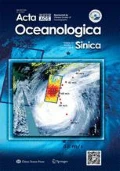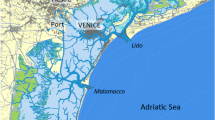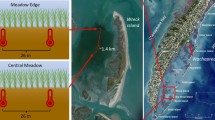Abstract
The Zhujiang River (Pearl River) Estuary (ZRE) is a very complicated and large-scale estuarine system in China. It consists of two parts: the river networks and the estuarine bays. Not only is the network system one of the most complicated in the world, but also each estuarine bay has a very special morphodynamic feature due to the geological settings. Morphological boundary conditions have direct effects on the energy dissipation and balance. On the basis of a three-dimensional (3-D) barotropic model whose domain includes the river networks and the estuarine bays, the energy budget is discussed under the influence of topography in the ZRE. The elevation and discharge of this model are validated by the observations collected in July 1999 and February 2001. The results show that (1) the source of energy in the ZRE is mainly generated by tides and river runoffs, which have an obvious seasonal change, and (2) there are some typical hotspots where the energy dissipation is 1–2 orders higher than those in the immediate upstream and downstream sections in the ZRE. These hotspots are linked with the small-scale dynamic structures (SSDS) and morphological units. On the basis of the characteristics of the morphology and the energy dissipation, the hotspots can be categorized into three types: the outlet of the ZRE, the meandering river, the branch and junction.
Similar content being viewed by others
References
Abdennadher J, Boukthir M. 2006. Numerical simulation of the barotropic tides in the Tunisian shelf and the Strait of Sicily. Journal of Marine Systems, 63(3–4): 162–182
Bao Yun, Lai Zhigang, Liu Huan. 2005. Hydrodynamic connection calculation by a baroclinic model for 1-D river network and 3-D river estuary at Zhujiang River estuary. Journal of Tropical Oceanography (in Chinese), 24(4): 67–72
Barthel K, Gade H G, Sandal C K. 2004. A mechanical energy budget for the North Sea. Continental Shelf Research, 24(2): 167–181
Chau K W, Jiang Y W. 2003. Simulation of transboundary pollutant transport action in the Pearl River delta. Chemosphere, 52(9): 1615–1621
Chen Xiaoling, Lu Jianzhong, Cui Tingwei, et al. 2010. Coupling remote sensing retrieval with numerical simulation for SPM study—Taking Bohai Sea in China as a case. International Journal of Applied Earth Observation and Geoinformation, 12(S2): S203–S211
Davies A M, Hall P, Howarth M J, et al. 2004. Tidal currents, energy flux and bottom boundary layer thickness in the Clyde Sea and North Channel of the Irish Sea. Ocean Dynamics, 54(2): 108–125
Dong Lixian, Su Jilan, Wong L A, et al. 2004. Seasonal variation and dynamics of the Pearl River plume. Continental Shelf Research, 24(16): 1761–1777
Foreman M G G, Cummins P F, Cherniawsky J Y, et al. 2006. Tidal energy in the Bering Sea. Journal of Marine Research, 64(6): 797–818
Foreman M G G, Sutherland G, Cummins P F. 2004. M2 tidal dissipation around Vancouver Island: an inverse approach. Continental Shelf Research, 24(18): 2167–2185
Gill A E. 1982. Atmosphere-Ocean Dynamics. New York: Academic Press, 76–82
Harari J, Camargo R. 2003. Numerical simulation of the tidal propagation in the coastal region of Santos (Brazil, 24°S 46°W). Continental Shelf Research, 23(16): 1597–1613
Hooke J M. 2007. Spatial variability, mechanisms and propagation of change in an active meandering river. Geomorphology, 84(3–4): 277–296
Hu Jiatang, Li Shiyu. 2008. One-dimensional salinity and three-dimensional baroclinic coupled model for simulating the flow in Pearl River Delta. Journal of Hydraulic Engineering (in Chinese), 39(11): 1174–1182
Hu Jiatang, Li Shiyu. 2009. Modeling the mass fluxes and transformations of nutrients in the Pearl River Delta, China. Journal of Marine Systems, 78(1): 146–167
Hua Zulin, Gu Li. 2009. Experiments of three-dimensional flow structure in braided rivers. Journal of Hydrodynamics, 21(2): 228–237
Jing Zhiyou, Qi Yiquan, Hua Zulin, et al. 2009. Numerical study on the summer upwelling system in the northern continental shelf of the South China Sea. Continental Shelf Research, 29(2): 467–478
Li Peiliang, Zhou Juan, Li Lei, et al. 2010. Tidal energy fluxes and bottom boundary layer energy dissipation in the Bering Sea. Journal of Marine Science and Application, 9(3): 340–346
Liu Huan, Wu Chaoyu, Bao Yun. 2011. Energy flux and dissipation in the Pearl River Estuary. Journal of Tropical Oceanography (in Chinese), 30(3): 16–23
Mao Qingwen, Shi Ping, Yin Kedong, et al. 2004. Tides and tidal currents in the Pearl River Estuary. Continental Shelf Research, 24(16): 1797–1808
Mellor G L, Yamada T. 1982. Development of a turbulence closure model for geophysical fluid problems. Reviews of Geophysics and Space Physics, 20(4): 851–875
Ning X, Chai Fei, Xue Huijie, et al. 2004. Physical-biological oceanographic coupling influencing phytoplankton and primary production in the South China Sea. Journal of Geophysical Research, 109(C10): doi: 10.1029/2004JC002365
Scarlatos P D. 1993. Tidal energy dissipation in well-mixed estuaries. Journal of Coastal Research, 9(4): 907–914
Seim H, Blanton J, Elston S. 2006. Tidal circulation and energy dissipation in a shallow, sinuous estuary. Ocean Dynamics, 56(3–4): 360–375
Smagorinsky J. 1963. General circulation experiments with the primitive equations: I. The base experiment. Monthly Weather Review, 91(3): 99–164
Stoesser T, Ruether N, Olsen N R B. 2010. Calculation of primary and secondary flow and boundary shear stresses in a meandering channel. Advances in Water Resources, 33(2): 158–170
Takasugi Y, Higo T, Fujiwara T. 1989. Energy balance of the tidal current in the Obatake Seto Strait. Journal of the Oceanographical Society of Japan, 45: 24–33
Taylor G I. 1919. Tidal friction in the Irish Sea. Philosophical Transactions of the Royal Society of London, A220: 1–33
Wang Chonghao, Wai W H O, Li Y S, et al. 2006. Modelling of the wave-current interaction in the Pearl River Estuary. Journal of Hydrodynamics: Ser B, 18(3): 159–165
Weber L J, Schumate E D, Mawer N. 2001. Experiments on flow at a 90° open-channel junction. Journal of Hydraulic Engineering, 127(5): 340–350
Wong L A, Chen J C, Dong Lixian. 2004. A model of the plume front of the Pearl River Estuary, China and adjacent coastal waters in the winter dry season. Continental Shelf Research, 24(16): 1779–1795
Wong L A, Chen J C, Xue Huijie, et al. 2003a. A model study of the circulation in the Pearl River Estuary (PRE) and its adjacent coastal waters: 1. Simulations and comparison with observations. Journal of Geophysical Research, 108(C5): doi: 10.1029/2002JC001451
Wong L A, Chen J C, Xue Huijie, et al. 2003b. A model study of the circulation in the Pearl River Estuary (PRE) and its adjacent coastal waters: 2. Sensitivity experiments. Journal of Geophysical Research, 108(C5): doi: 10.1029/2002JC001452
Wu Chaoyu, Wei Xing, Ren Jie, et al. 2010. Morphodynamics of the rockbound outlets of the Pearl River estuary, South China—A preliminary study. Journal of Marine Systems, 82(S1): S17–S27
Wu Chaoyu, Wu Jiaxue. 1994. Small scale dynamic structures and their sedimentation effects in estuarine environment. In: Arcilla A S, Stive M J F, Kraus N C, eds. Coastal Dynamics’ 94, Proceedings of an International Conference on the Role of the Large Scale Experiments in Coastal Research. New York: ASCE, 158–174
Wu Chaoyu, Zhou Di. 2001. Long-term morpho-dynamics in special type of estuary. Science in China: Series B, 44(S1): 112–125
Zhang Heng, Li Shiyu. 2010. Effects of physical and biochemical processes on the dissolved oxygen budget for the Pearl River Estuary during summer. Journal of Marine Systems, 79(1–2): 65–88
Zhong Liejun, Li Ming. 2006. Tidal energy fluxes and dissipation in the Chesapeake Bay. Continental Shelf Research, 26(6): 752–770
Author information
Authors and Affiliations
Corresponding author
Additional information
Foundation item: The National Basic Research and Development Program (973 program) of China under contract No. 2013CB956502; the National Natural Science Foundation of China under contract No. 41006050; the Open Research Foundation of Pearl River Hydraulic Research Institute of China under contract No. 2013KJ07.
Rights and permissions
About this article
Cite this article
Liu, H., Wu, C. & Wu, Y. The energy budget under the influence of topography in the Zhujiang River Estuary in China. Acta Oceanol. Sin. 34, 148–158 (2015). https://doi.org/10.1007/s13131-015-0606-y
Received:
Accepted:
Published:
Issue Date:
DOI: https://doi.org/10.1007/s13131-015-0606-y




